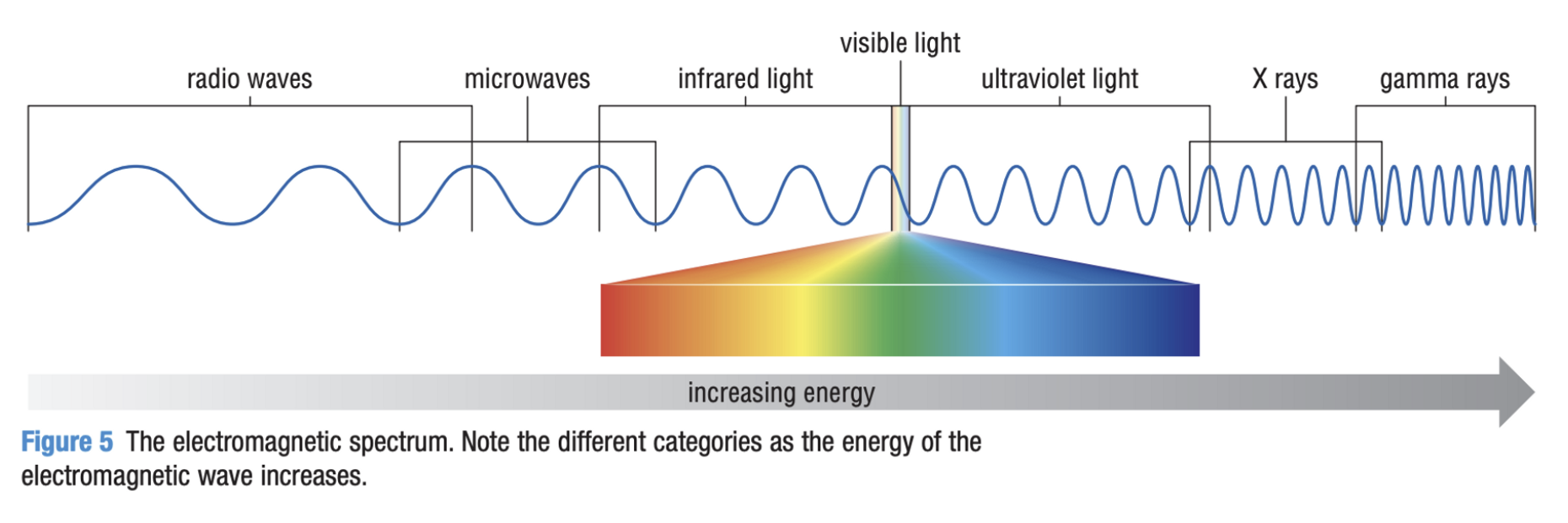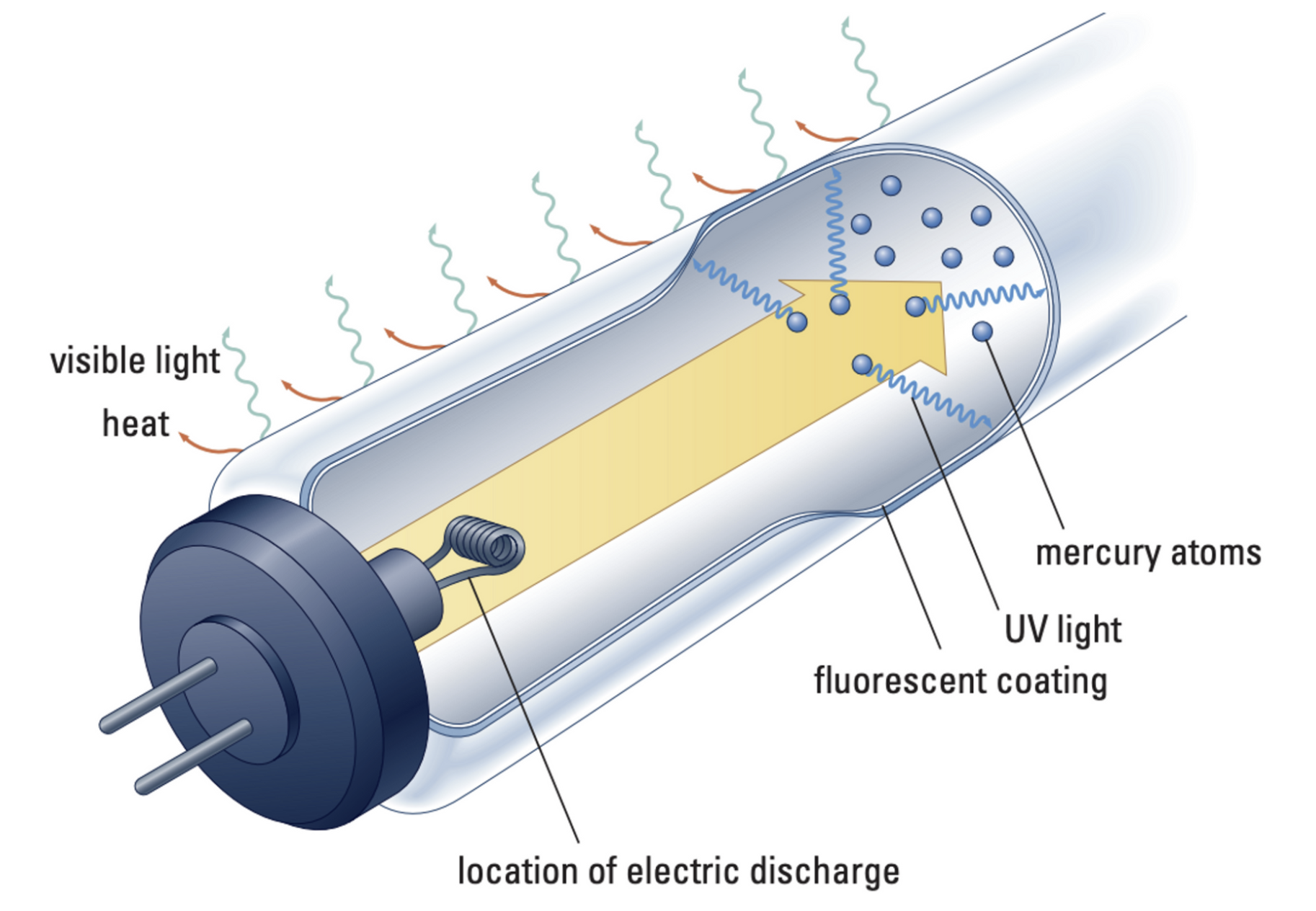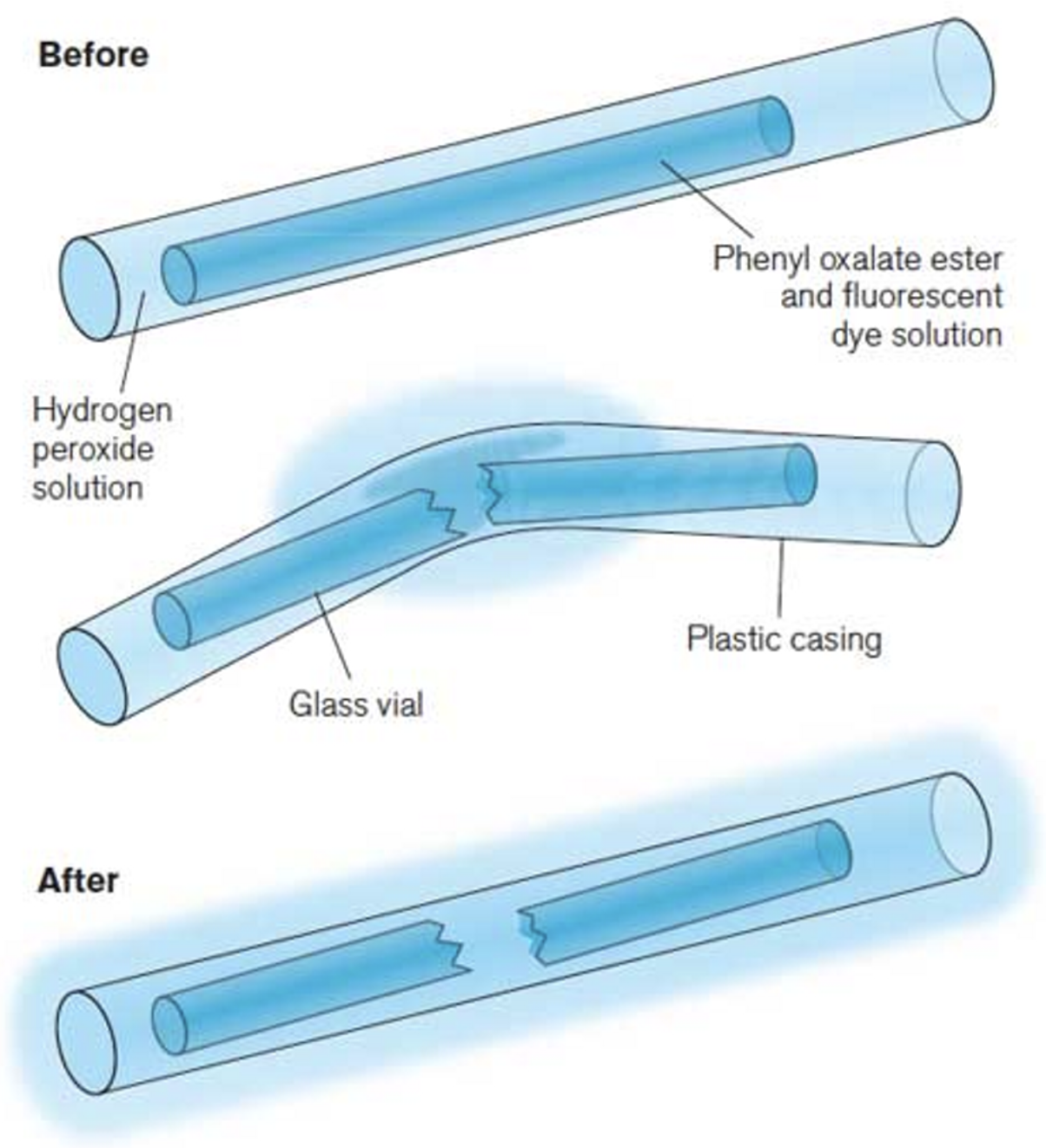Chapter 11 - Nelson Science 10
0.0(0)
0.0(0)
Card Sorting
1/57
Study Analytics
Name | Mastery | Learn | Test | Matching | Spaced |
|---|
No study sessions yet.
58 Terms
1
New cards
Medium
Any physical substance through which energy can be transferred
2
New cards
Radiation
A method of energy transfer that does not require a medium; the energy travels at the speed of light.
3
New cards
Electromagnetic Waves
A wave that has both electric and magnetic parts, does not require a medium, and travels at the speed of light.
4
New cards
Electromagnetic Spectrum
The classification of electromagnetic waves by energy

5
New cards
Applications of **radio waves**
* AM/FM Radio
* TV Signals
* Cellphone communication
* Radars
* Astronomy (e.g. discovery of pulsars)
* TV Signals
* Cellphone communication
* Radars
* Astronomy (e.g. discovery of pulsars)
6
New cards
Applications of **microwaves**
* Telecommunications
* Microwave ovens
* Astronomy (e.g. background radiation from the Big Bang)
* Microwave ovens
* Astronomy (e.g. background radiation from the Big Bang)
7
New cards
Applications of **infrared light**
* Remote controls (e.g. DVD players and game controllers)
* Lasers
* Heat detection
* Keeps food warm (e.g. fast-food restaurants)
* Astronomy (e.g. discovering chemical composition of celestial bodies)
* Physical therapy
* Lasers
* Heat detection
* Keeps food warm (e.g. fast-food restaurants)
* Astronomy (e.g. discovering chemical composition of celestial bodies)
* Physical therapy
8
New cards
Applications of **visible light**
* Human vision
* Theatre/convert lighting
* Rainbows
* Visible lasers
* Astronomy (e.g. optical telescopes, discovering chemical composition of celestial bodies)
* Theatre/convert lighting
* Rainbows
* Visible lasers
* Astronomy (e.g. optical telescopes, discovering chemical composition of celestial bodies)
9
New cards
Applications of **ultraviolet light**
* Causes skin to tan and sunburn
* Increases risk of developing skin cancer
* Stimulates production of vitamin D
* Kills bacteria in food and water (sterilization)
* “Black” lights
* Ultraviolet lasers
* Astronomy (e.g. discovering chemical composition of celestial bodies)
* Increases risk of developing skin cancer
* Stimulates production of vitamin D
* Kills bacteria in food and water (sterilization)
* “Black” lights
* Ultraviolet lasers
* Astronomy (e.g. discovering chemical composition of celestial bodies)
10
New cards
Applications of **x-rays**
* Medical imaging (e.g. teeth and broken bones)
* Security equipment (e.g. scanning luggage at airports)
* Cancer treatment
* Astronomy (e.g. study of binary star systems, black holes, centres of galaxies)
* Security equipment (e.g. scanning luggage at airports)
* Cancer treatment
* Astronomy (e.g. study of binary star systems, black holes, centres of galaxies)
11
New cards
Applications of **gamma rays**
* Cancer treatment
* Astronomy (e.g. study of nuclear processes in the universe)
* Product of some nuclear decay
* Astronomy (e.g. study of nuclear processes in the universe)
* Product of some nuclear decay
12
New cards
Luminous
Produces its own light (e.g. sun, candles)
13
New cards
Non-luminous
Does not produce its own light (e.g. pencils, textbooks)
14
New cards
As an object gets hotter, the colours of light produced change from…
from red, to orange, to yellow, to white, and then to bluish-white.
15
New cards
Incandescence
Production of light as a result of high temperature
16
New cards
How do incandescent light bulbs work?
* Has a thin wire filament, usually made of tungsten, that glows as electricity passes through it
* Filament becomes so hot that it gives off visible light
* Also emits infrared light that you feel as heat radiating from the bulb
* Filament becomes so hot that it gives off visible light
* Also emits infrared light that you feel as heat radiating from the bulb
17
New cards
What must be removed for incandescent light bulbs to work?
* For an incandescent bulb to work, all the air from the bulb must be removed and replaced with non-reactive gas. (O2 can cause filament to burst into flames)
* Without O2 present, the filament eventually disintegrates and breaks
* Without O2 present, the filament eventually disintegrates and breaks
18
New cards
Why are incandescent light bulbs inefficient?
Only 5-10% of electricity is actually converted into visible light, the rest is converted into infrared light (heat)
19
New cards
Electric Discharge
The process of producing light by passing an electric current through a gas (e.g. neon lights)
20
New cards
How was electric discharge light production discovered?
* Heinrich Geissler created a powerful vacuum pump to remove most of the air from a closed tube.
* The remaining air glowed when an electric current was passed through it.
* Colour of glow depended on the type of gas that was inside the tube
* The remaining air glowed when an electric current was passed through it.
* Colour of glow depended on the type of gas that was inside the tube
21
New cards
Phosphorescence
The process of producing light by the absorption of ultraviolet light resulting in the emission of visible light over an extended period of time. (e.g. glow-in-the-dark)
22
New cards
How do phosphors work?
* Phosphors absorb light energy, primarily ultraviolet light.
* It keeps some of the energy and releases visible light of lower energy
* It keeps some of the energy and releases visible light of lower energy
23
New cards
Fluorescence
The immediate emission of visible light as a result of the absorption of ultraviolet light
* E.g. detergent to make clothes brighter
* E.g. detergent to make clothes brighter
24
New cards
How do fluorescent lights work?
* Fluorescent lights make use of both electric discharge and fluorescence
* Tube is filled with low-pressure mercury vapour and the inner surface is coated with a fluorescent material.
* When turned on, the electric current causes the mercury atoms to emit ultraviolet light.
* UV light then strikes the fluorescent inner surface of the tube, resulting in the production of visible light.
* Tube is filled with low-pressure mercury vapour and the inner surface is coated with a fluorescent material.
* When turned on, the electric current causes the mercury atoms to emit ultraviolet light.
* UV light then strikes the fluorescent inner surface of the tube, resulting in the production of visible light.

25
New cards
Pros and cons of fluorescent light
* 4-5x more efficient than incandescent bulbs (less heat + less electricity)
* Downside: contain mercury and should not be disposed of with regular household waste (hazardous)
* Downside: contain mercury and should not be disposed of with regular household waste (hazardous)
26
New cards
Chemiluminescence
The direct production of light as the result of a chemical reaction with little or no heat produced
27
New cards
How do chemiluminescent light sticks work?
* Light sticks operate by causing 2 chemicals to mix
* One chemical is in a narrow, small glass vial in the middle of the stick, the second is in the main body of the stick.
* Bending causes the small glass vial to break, allowing the chemicals to mix and produce visible light.
* One chemical is in a narrow, small glass vial in the middle of the stick, the second is in the main body of the stick.
* Bending causes the small glass vial to break, allowing the chemicals to mix and produce visible light.

28
New cards
Why are chemiluminescent lights good?
* Inexpensive to manufacture
* Very popular for use in camping, law enforcement, military personnel, entertainment venues, emergency situations, underwater divers
* Very popular for use in camping, law enforcement, military personnel, entertainment venues, emergency situations, underwater divers
29
New cards
Bioluminescence
The production of light in living organisms as the result of a chemical reaction with little or no heat produced
30
New cards
Glow in a firefly is caused by…
A chemical reaction between oxygen and luciferin (enzyme)
31
New cards
Triboluminescence
Production of light from fiction as a result of scratching, crushing, or rubbing certain crystals
32
New cards
Full name for LED
Light-Emitting Diodes
33
New cards
LEDs
Light produced as a result of an electric current flowing in semiconductors
34
New cards
Semiconductors
A material that allows an electric current to flow in only one direction
35
New cards
Why are LED lights good?
Compared to incandescent bulbs, LEDs do not require a filament, do not produce as much heat as a by-product, and is more energy efficient
36
New cards
Light ray
A line on a diagram representing the direction and path that light is travelling
37
New cards
Geometric optics
The use of light rays to determine how light behaves when it strikes objects
38
New cards
Incident light
Light emitted from a source that strikes an object
39
New cards
Transparent
When a material transmits all or almost all incident lights; objects can be clearly seen through the material (e.g. clear glass)
40
New cards
Translucent
When a material transmits some incident light but absorbs or reflects the rest; objects are not clearly seen through the material (e.g. frosted glass)
41
New cards
Opaque
When a material does not transmit any incident light; all incident light is either absorbed or reflected; objects behind the material cannot be seen at all (e.g. cardboard)
42
New cards
Image
Reproduction of an object through the use of light
43
New cards
Mirror
Any polished surface reflecting an image
44
New cards
Reflection
The bouncing back of light from a surface
45
New cards
Describe the layers of mirrors
Mirrors consist of 2 parts: front part is a sheet of glass and the back part is a thin layer of reflective silver or aluminum.
* The symbol used in physics to represent a mirror refers only to the reflective thin film
* The symbol used in physics to represent a mirror refers only to the reflective thin film
46
New cards
Incident ray
The incoming ray that strikes a surface
47
New cards
Reflected ray
The ray that bounces off a reflective surface
48
New cards
Normal
The perpendicular line to a mirror surface
49
New cards
Perpendicular
At right angles
50
New cards
Angle of Incidence
The angle between the incident ray and the normal
51
New cards
Angle of Reflection
The angle between the reflected ray and the normal
52
New cards
The 2 laws of reflection
1. Angle of incidence = angle of reflection
2. The incident ray, the reflected ray, and the normal all lie in the same plane
53
New cards
Specular reflection
* Reflection of light off a smooth surface
* A series of parallel incident rays that strike a smooth surface will have identical angles of incidence (meaning that angles of reflection will all be identical and reflected rays will all be parallel to each other)
* A series of parallel incident rays that strike a smooth surface will have identical angles of incidence (meaning that angles of reflection will all be identical and reflected rays will all be parallel to each other)
54
New cards
Diffuse reflection
Reflection of light off an irregular or dull surface
* Reflected rays would be scattered in many different directions
* Reflected rays would be scattered in many different directions
55
New cards
Virtual image
An image formed by light coming from an apparent light source; light is not arriving at or coming from the actual image location.
(Appears behind the mirror)
(Appears behind the mirror)
56
New cards
Lateral inversion
The orientation of an image in a plane mirror that is backwards and in reverse order
57
New cards
What does the acronym SALT mean?
1. Size of image (compared to the object: same size, smaller, or larger)
2. Attitude of image (which way the image is oriented compared to the object: upright or inverted)
3. Location of image
4. Type of image (real or virtual). A real image is an image formed where light is actually arriving at the same location.
58
New cards
Describe an image in a plane mirror using SALT
An image in a plane mirror is always the same size as the object (size), upright by laterally inverted (attitude), behind the mirror and the same distance behind as the object is in front (location), and virtual (type).